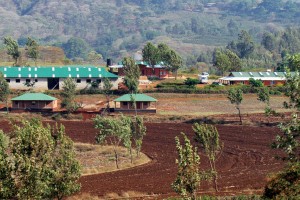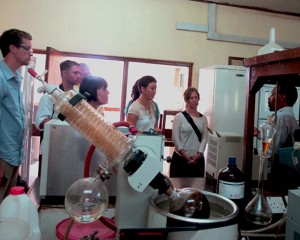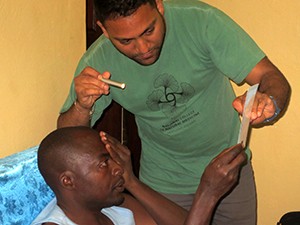After another grueling drive, we arrived in Kuratu yesterday. Ngorongoro Crater is at Kuratu, and we’ll be on safari there tomorrow. I’ve never done this safari, and I’m really looking forward to it. It’s supposed to be one of the more beautiful safaris, and has the big five for animals (elephants, lions, buffalo, and shoot, I forget the other ones.) We also came to Kuratu to visit FAME clinic and hospital. Great place. You should check out their website.
The last couple of days in Moshi were interesting. In reality, all of this trip has been interesting. It’s so much fun seeing Africa through the eyes of my students. Their questions and observations have really enriched my own experience. For example, Crane has become so over-exposed to children yelling “Hi mzungu” (translates to “hi white person!”) at us that he’s taken to calling “Hi mzungu” at all of the other tourists. Our drivers also add a new perspective to the trip. Sky and George still want to please us because we’re visitors, but Julius is comfortable enough with me at this point that he’s willing to be honest – sometimes brutally so.
Most recently his comments were about the clinic day in Mowo. If I haven’t said it before, Mowo is a little village (roughly 1900 people) at the base of Kilimanjaro, about 45 minutes from Moshi. Mowo is up a little dirt road – far enough up Kili that the residents rarely make it out of the village. There is one car in town, and the dala dala goes through twice a day. Other than that, if you’re going to go somewhere outside of the village, you go by piki piki (motorcycle). The villages aren’t like our towns because houses aren’t next to each other. They’re spread out across the hills and valleys of the foothills, and connected by footpaths. The village covers around five miles of land and butts up against other villages on either side of it. The village center is a school, church, and barbershop. Last year we spent about four days in Mowo. This year, it was two days, but many of the students did a village stay and slept with families in the village. They had a wonderful time, and suggested that we lengthen the time in the village next year.
 On the second day in Mowo, some of our group decided to hold an impromptu clinic for village residents. They saw about 20 patients. They saw everything from ringworm to Alzheimers. I wasn’t there because I stayed in Moshi with the sick students.
On the second day in Mowo, some of our group decided to hold an impromptu clinic for village residents. They saw about 20 patients. They saw everything from ringworm to Alzheimers. I wasn’t there because I stayed in Moshi with the sick students.
Julius and I were both conflicted about the clinic day, and I have to admit, I’m still struggling with it. On the surface, providing medical care to people who need it seems ideal. However, the way in which it was provided is a form of medical tourism, to which I’m personally opposed. There are multiple forms of medical tourism. One happens when people go outside the country to get a surgery for cheap. Another form of medical tourism is when doctors swoop in for a day or a week or a month, and provide temporary care. The issue is that it often leaves patients with no follow-up care. There can be questions and fears – and no one to answer them. There can be a lack of prescription refills, or side-effects from drugs which aren’t addressed. When patients go into a local clinic, they may also get conflicting diagnoses from local doctors, and that can leave them panicked and confused.
In the worst cases, medical tourism can make disease worse. An example of this occurred with multi-drug resistant tuberculosis. The Norwegians came in to help with TB, and brought antibiotics. But they stayed for one month, and the course of antibiotics for TB requires six months. When they left, the Tanzanians had no access to additional antibiotics, and the TB bacteria became resistant to that antibiotic. Then the Americans came in and brought a different antibiotic… and the cycle repeated. Then the Brits came in and brought their antibiotics for a month, and a third antibiotic resistance was generated. The result for Africa is a form of TB that is near impossible to treat – all because people were trying to be helpful.
 As Julius put it, it seems great to have doctors show up, but why can’t they bring a local doctor with them? That way the villagers can get follow-up care. And our doctors and students didn’t have medicine with them. So they could diagnose, but not treat. It confused Julius why we would do this. He also pointed out that it can disrupt the social politics in the village when only a small number of people who need care get care. He’s right. If our medical day had been better planned, we would have brought a physician and medicine with us, and I will make certain this happens in the future. The other solution to medical tourism is to have permanent sites in the countries. My hope is that NUNM will have a permanent site in Mowo one day.
As Julius put it, it seems great to have doctors show up, but why can’t they bring a local doctor with them? That way the villagers can get follow-up care. And our doctors and students didn’t have medicine with them. So they could diagnose, but not treat. It confused Julius why we would do this. He also pointed out that it can disrupt the social politics in the village when only a small number of people who need care get care. He’s right. If our medical day had been better planned, we would have brought a physician and medicine with us, and I will make certain this happens in the future. The other solution to medical tourism is to have permanent sites in the countries. My hope is that NUNM will have a permanent site in Mowo one day.
Sometimes Americans/Mzungus get ahead of themselves. We get to a country that clearly needs so many things, and we have a strong desire to help. We think we have the knowledge or resources that they need, and it makes us feel good to be needed. But it is not always what the Tanzanians need. FAME hospital has a great system where they pair the American doctors with a Tanzanian doctor. This allows the Tanzanian doctors to learn what the American doctors know, and the knowledge stays in Tanzania when the American doctors go home. The staff at FAME was telling us that physicians come to Tanzania and want to practice without a license. Just as America has laws to protect its people, and it’s difficult for foreign doctors to become licensed in America, foreign physicians need to become licensed in Tanzania. So even though Tanzania needs physicians and medical care, it’s better to go through the correct channels and provide legal care.
Another mixed blessing that happens here (at FAME and at other hospitals I’ve visited) is donations of old medical equipment, and random discarded things. Often the equipment is broken, or missing pieces. Those missing pieces don’t exist here – and there’s no bioengineers around to fix broken equipment. There’s also no place to dispose of broken equipment. The volunteer director at FAME showed us a broken medical scissors that had been donated that had a note on it from the USA saying that it couldn’t be fixed… So it was sent to a hospital in Tanzania? Makes no sense. While it’s admirable to give things to a country that is lacking, they really do better with new equipment that works, and service contract that will allow them to fix their own equipment with a skype call.
 While most of the students were in the village, the rest of the students were with me in Moshi. We took the donated eye-glasses to Kilimanjaro Christian Medical School (KCMC). We had about 80 pairs of glasses that Americans had sent with us to deliver to Tanzanians who need them. KCMC will perform the eye exams, and provide free glasses to locals. Donating the glasses was more difficult than you might expect. A duffle bag full of glasses is very very valuable. So it can’t be dropped off with an administrative
While most of the students were in the village, the rest of the students were with me in Moshi. We took the donated eye-glasses to Kilimanjaro Christian Medical School (KCMC). We had about 80 pairs of glasses that Americans had sent with us to deliver to Tanzanians who need them. KCMC will perform the eye exams, and provide free glasses to locals. Donating the glasses was more difficult than you might expect. A duffle bag full of glasses is very very valuable. So it can’t be dropped off with an administrative
person with the expectation that it will make it to the eye clinic. There’s too much temptation for that person to sell the glasses and make money to support their family. Thus, we had to phone everyone I knew from KCMC from last year so that the nurse who picked up the glasses was accountable to them. There was a lot of gratitude for the glasses, and I think we’ll bring glasses again next year. Though they were difficult to carry, we were amazed at how many people – even our drivers – needed glasses. I’m really grateful to all of the people who donated glasses for this trip.
Our group has been all about gratitude, and the students regularly find themselves grateful for different things – a bed without fleas, a pillowcase, toilet paper, a hot shower, new tires to fix the flats we’ve had, snacks for the cars, occasional internet, and Imodium to name a few. We’ve been creating our own form of Tanzanian decadence as well. When we were at Pam’s house in Tanga, we had pedicures. I’m currently ready for another one as my feet are so dry that my heels have cracked and bled. Traveling with a group of naturopathic and Chinese medicine students means that you always have neck rubs, and even some rib cracking when necessary.
To add some joy to our days, we decided early on to start celebrating birthdays. There was one slight hitch to this decision when we realized that no one in the group was having a birthday while we’re here. But that hasn’t slowed us down. The group decided that it would be Greg’s birthday, every day. We’ve been singing to him in every restaurant, and have even found birthday cake on three separate occasions. We even located some candles. Greg is the perfect person to have a perpetual birthday because he is just the right level of irritated and amused by our antics. We figure that at this rate, he’ll be in his 50s by the time we get home…
Lest you think we are just eating cake, you should know that the food has ranged from gourmet Tanzanian – things like bean and banana stew and chapattis – to starving medical student – nutella and peanut butter on chocolate coconut cookies, and crepes with avocado and mango. Amelia has discovered the myriad of flavor of chips available around here. Ketchup flavored bugles, Naughty Tomato Chips, and Marsala Munch seem to be the most popular, but she’s still taste testing her way across Tanzania.
I’ll wrap this letter up for now. I’m saving my computer battery for the game drive e-mail tomorrow!
Napenda!
Heather
